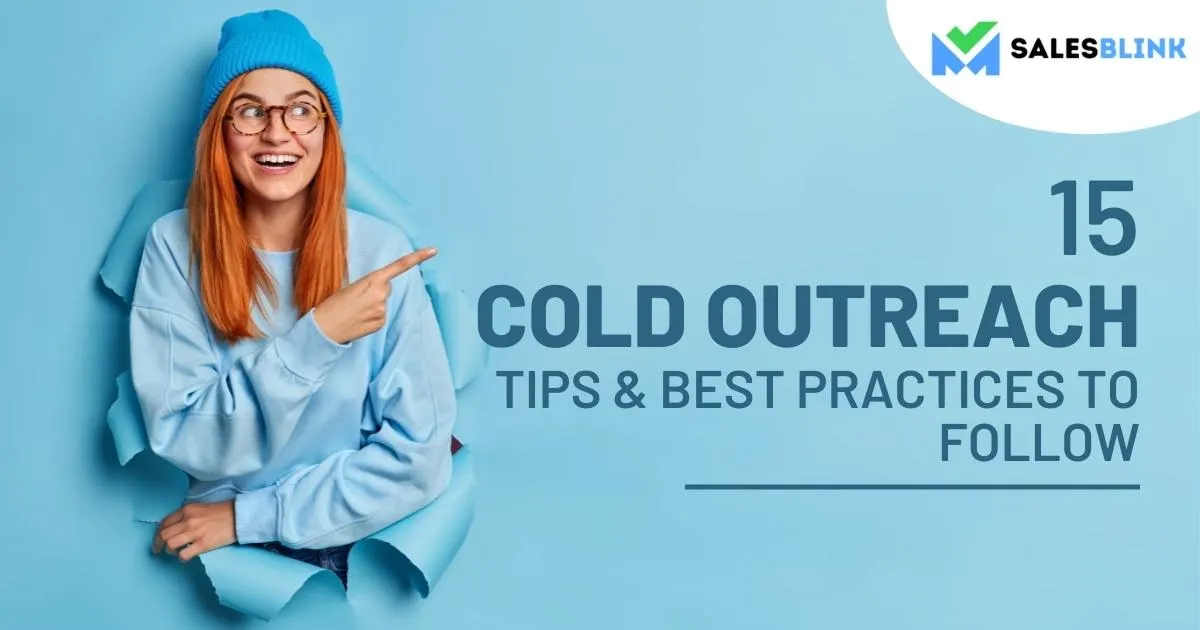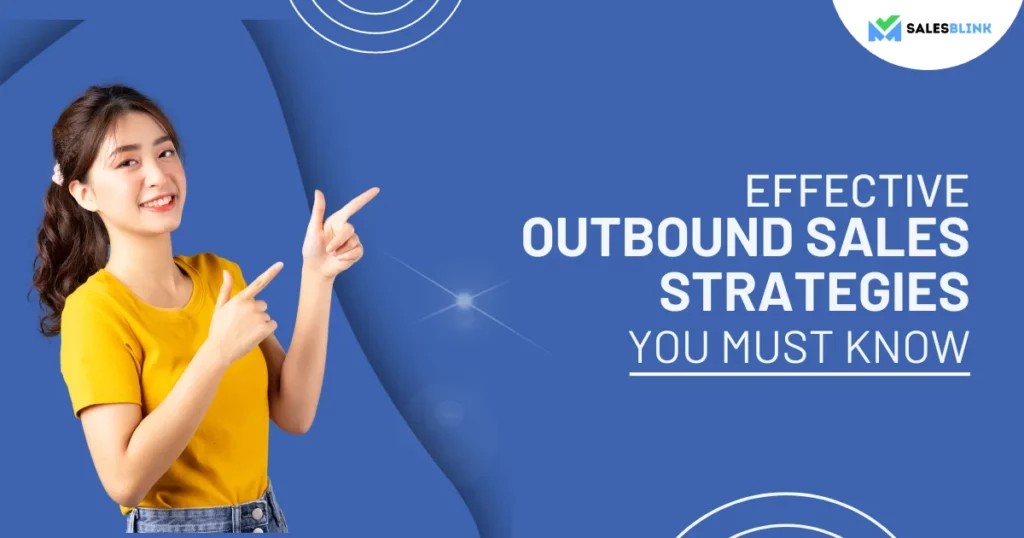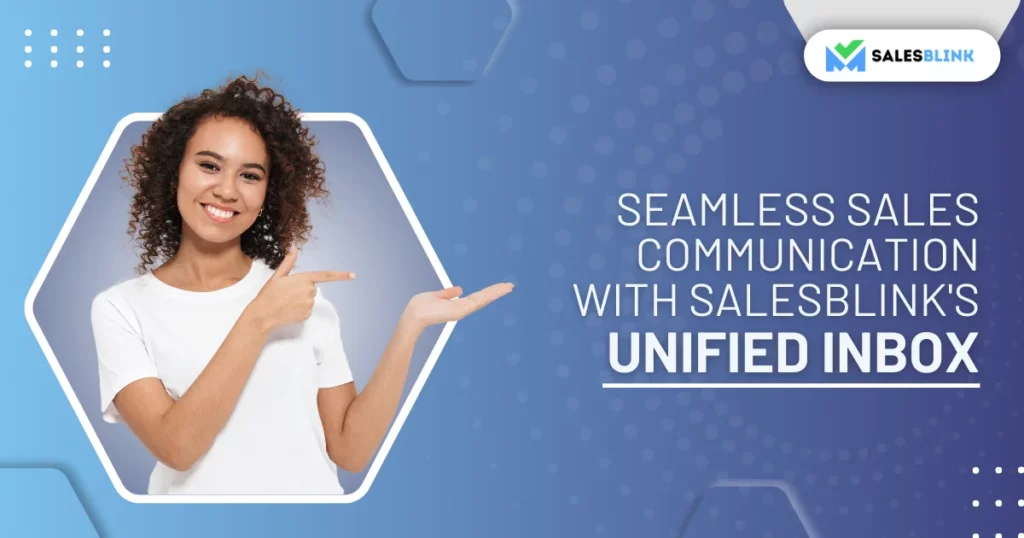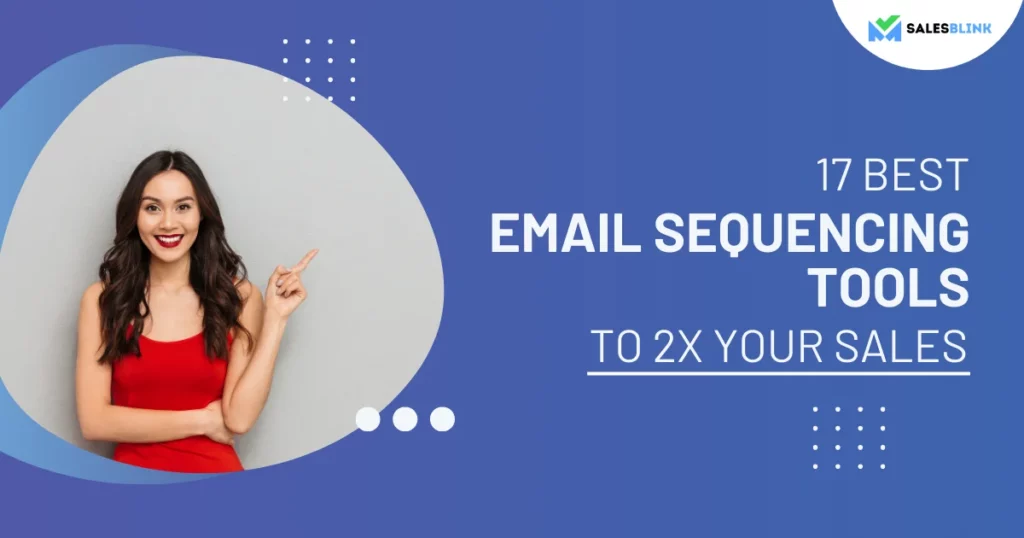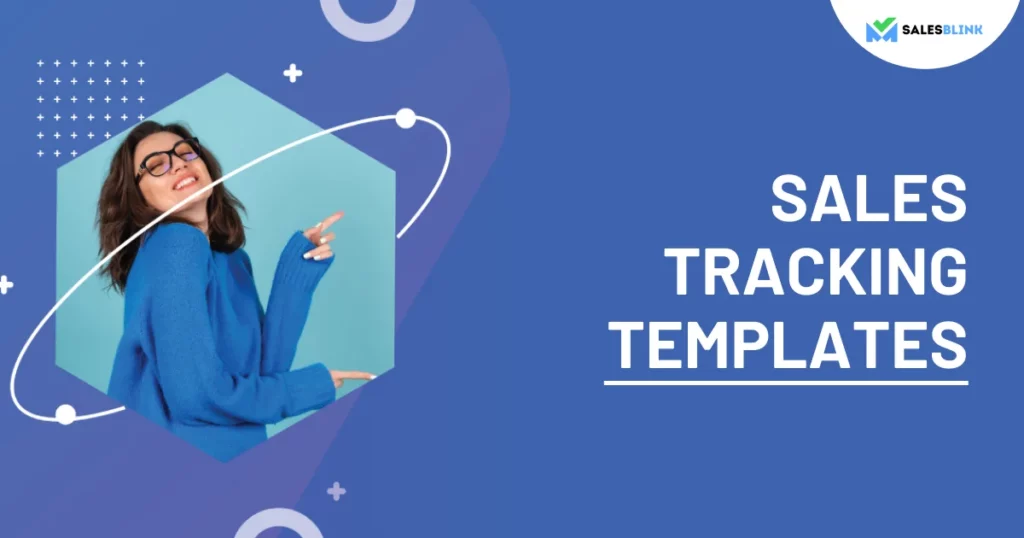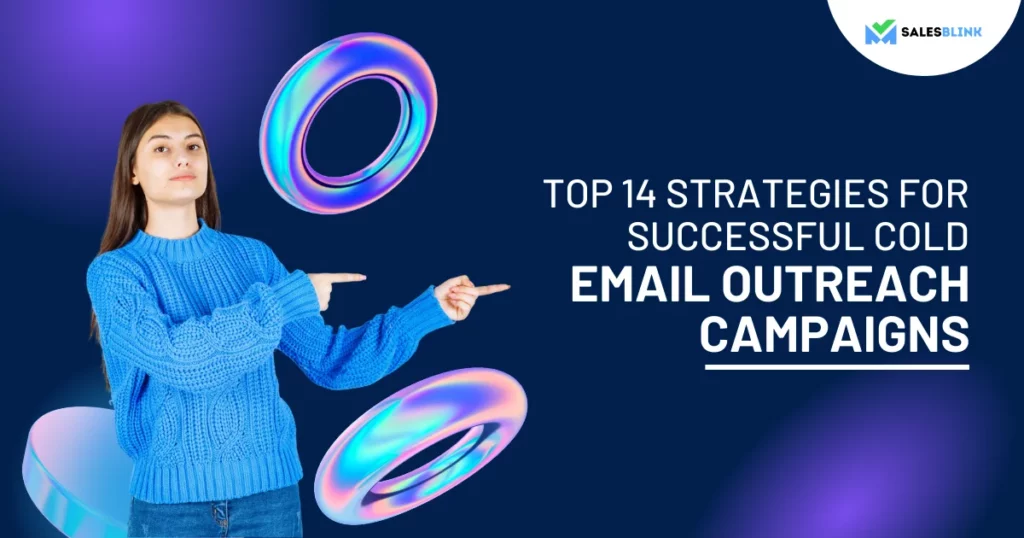Cold Outreach Tips & Best Practices To Follow (+ 15 Templates)
Do you know that 75% professionals are willing to schedule a meeting based on a cold email or call? Isn’t that enough to show that cold outreach works? However, to connect with people you don’t know, and for that, you have to master the cold outreach game. You have to make yourself heard to initiate conversations with prospects to enter the sales funnel. And you may not have the skill in you at present.
Don’t worry! We’ve got your back.
In this blog post, we’ll take a look at how to do cold outreach the right way, understand the different channels used for reaching out to prospects, and also find out the best practices for sales outreach through each of them.
So, let’s begin!
Table Of Contents
- What Is Cold Outreach?
- What Is Cold Email Outreach?
- Cold Emailing Tips Before You Start A Campaign
- Steps to Make Your Cold Email Outreach A Hit
- Reasons To Use Cold Emails Outreach
- Benefits Of Cold Email Outreach
- 15 Cold Email Outreach Best Practices
- Cold Email Outreach Templates That Work
- What Is Cold Calling?
- Cold Calling Best Practices
- Cold Calling Script Templates
- What Is LinkedIn Outreach, And Why Do You Need It?
- Tips For Writing The Perfect LinkedIn Cold Outreach Message
- LinkedIn Templates To Get More Responses
- FAQs
What Is Cold Outreach?
Cold outreach refers to reaching out to prospects who don’t know anything about your business or the product/service you are offering. It is a cost-efficient and effective way of getting people to know about your product or service.
The only way to reach out to potential customers a few decades back was through cold calling. While it is still a very relevant and widely-used approach, there is the use of email in modern cold outreach to connect with prospects. Recently, salespeople have shifted to social media channels, and they seem to work quite well.
Following are some of the key points that set aside modern cold outreach from that of the yesteryears,
1. Targeted outreach
Salespeople aim at a more targeted outreach instead of sending thousands of emails to random people or picking up the phone and calling the first number in the telephone directory. They create buyer personas and reach out to those who seem a good fit.
2. Personalization
Call scripts are personalized because the generic approach does not go too well with prospects. Also, there is the need to put in efforts to customize the message based on the target audience.
3. Multi-Channel outreach
Instead of choosing a single outreach channel, you can use multi-channels outreach such as phone, email, and LinkedIn. Salespeople prefer using more than one channel because there is a higher chance of closing the deal.
In this post, we’ll discuss the following 3 most effective types of cold outreach, namely cold emailing, cold calling and LinkedIn outreach.
What Is Cold Email Outreach?
Let’s begin with cold email outreach and find what it is, why you should use it, the benefits it has to offer, and the best practices to follow.
Cold email outreach refers to sending emails to individuals with no existing relationship with you and your business. So, the recipients don’t even anticipate getting an email from you as they don’t know you.
The aim is to acquire leads, but the relationship-building approach is used instead of immediate selling.
It is a rather conventional practice to use email for cold outreach, but it is quite effective in getting leads to date. Statistics say that email outreach provides 40 times more customer acquisition than social channels, and it is still the most popular channel for cold outreach.
Cold Emailing Tips Before You Start A Campaign
Are you convinced that cold emailing is a great cold outreach channel? However, before starting with cold email campaigns, you have to bear a few things in mind that will go a long way in helping you achieve your sales goal.
1. Go for automation
Sending a few emails is fine, but when you have to deal with a high email volume, you have to seek the help of email automation tools. You can personalize the emails at scale so that they don’t look too generic. Just make sure that you use the right tools.
2. Don’t only focus on selling
You are more likely to get responses when you are looking to build relationships with prospects rather than aggressively selling your product or service. As you aim at connecting with the other person, sales will follow.
3. Follow up extensively
With follow-up, you can turn a ‘No’ into a ‘Yes’ but make sure that you know the difference between being persistent and annoying. Create a follow-up email cadence where you space out your emails properly.
4. Put in efforts
If you want to make an impact through your email, you have to focus on making it worth reading. A generic and unconvincing email that isn’t even relevant will have no takers. Therefore, you have to put in efforts to make your email stand out from the rest of the emails in the prospect’s inbox.
Steps to Make Your Cold Email Outreach A Hit
There are a few steps that you must follow to get the best results from your cold outreach,
1. Try to understand your audience
There is no prize for guessing that you have to understand your target audience before starting your outreach campaign. Find out the pain points they face and how you can pitch your product or service to them. You have to keep your approach customer-centric and convince them how your offering can bring positive changes to their lives.
2. Know the psychology of prospects
You can succeed if you can evoke emotions through your messages. Instead of focusing on your product’s features, you have to talk about the benefits of using your offering. Customers most often want to know what you’re offering them. No matter how amazing your product or service may be, it will sell only when you market it from the prospect’s point of view. The first thing that arises in their mind is – ‘what is in it for me?’ If you can answer that, you win!
3. Test your emails before launch
Once you have crafted your emails, you should ask your colleagues to read through them and get their suggestions on improving the emails. This way, you can make improvements and get much better results.
Reasons To Use Cold Email Outreach
Following are the top reasons that make most sales teams give the highest priority to cold email outreach,
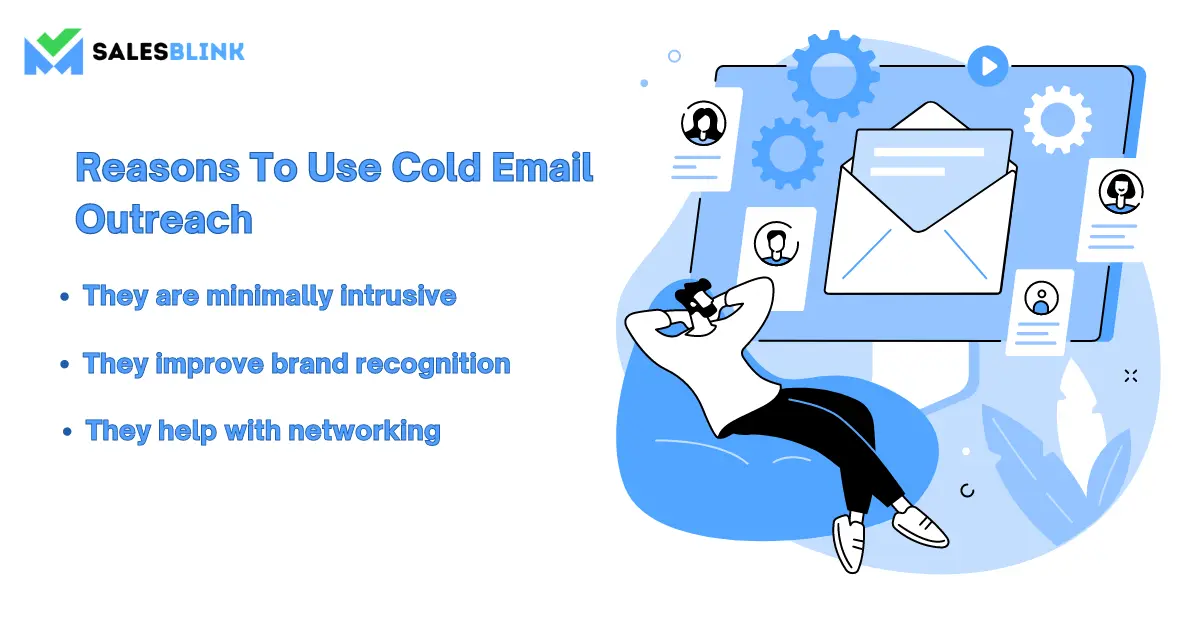
1. They are minimally intrusive
Unlike cold calling, cold emailing is the least intrusive. It doesn’t disturb the recipient in the middle of an important task and is, therefore, less annoying. Recipients are free to open their email inbox at their convenience and read the email you sent them.
2. They improve brand recognition
With cold emailing, you can reach out to several prospects. In a way, it makes potential customers get to know about your solution and helps improve the brand recognition of your business. This way, it benefits your business even if you don’t get a lot of replies to your email.
3. They help with networking
Apart from increasing brand awareness, cold email outreach helps with networking. Even if the recipient doesn’t reply to you directly, they may share your email with other individuals who may be
Benefits Of Cold Email Outreach
Cold email outreach has a lot of advantages to offer, especially for growing businesses. Let’s take a look at what they are,
1. Cost-effectiveness
You only need an email account to begin your outreach which is not expensive. If you want to automate the outreach, you need to choose a tool to make your job easier. Even after investing in a tool, email outreach won’t be too heavy on your pocket.
2. Ability to scale the outreach
With a sales outreach automation tool, you can scale the outreach process easily. You can reach out to more people with the same effort and maximize the results. It is also possible to reach out to different segments.
3. Reliability
After you understand which approach will be the best for outreach, cold emailing would be a channel you can rely on.
15 Cold Email Outreach Best Practices
Some cold email tips and practices will help you get great results if followed right. Let’s discuss them below,

1. Keep it short and sweet
Prospects receive scores of emails a day. You can make their lives easier by sending compact and well-crafted emails that don’t take too long to read. Keep them no longer than 100 words. Also, as most people skim through the email, you must keep the sentences and paragraphs short. Keep only 2 to 3 sentences in every section to enhance readability.
You are more likely to draw the prospect’s attention with to-the-point emails rather than long stories singing praises for the product or service you offer.
2. Use catchy subject lines
You have to focus on keeping your subject line catchy if you want to draw the attention of prospects. A drab and boring subject line will repel readers no matter how well-written your email body is because your subject line is the first part of the email that prospects see. Therefore, you have to put in extra effort to make it striking enough for the prospect. Focus on their needs right from the subject line so that they can connect better with you and feel curious to read the email.
Some of the best ways to make your cold email subject lines stand out are by arousing curiosity, a sense of urgency, FOMO (fear of missing out), and excitement. If you use these tactics in your cold email subject lines, the prospect is more likely to get attracted to your email.
3. Focus on the intro
The way you begin your email matters a lot. The fate of your message depends on the intro line. If it is no good, the prospect might ignore your email. It would be a good idea to mention a common interest in the beginning to get the recipient’s attention. You can also compliment or talk about their pain point in their language for better understanding.
4. Keep the language simple
It is always better to avoid using jargon and technical words because you have to draw the prospect towards you and not drive them away! Keep the tone of your email conversational and help the reader understand what you are trying to convey. They will appreciate the usage of simple language in your email.
5. Use emojis
While the popular opinion is that B2B emails have to look serious and to the point, there is no harm in wading into a little bit of humor. Prospects may end up liking it. You can use emojis to make your email more effective and relatable to the target audience.
6. State the purpose of reaching out
Your cold outreach email needs to have a purpose as nobody has the time for emails with no clear intent. There can be any purpose for reaching out, here we have mentioned a few,
- Reaching out after the prospect took an action
- Sharing a resource (blog post, whitepaper or ebook).
- Offering a free trial or a demo
- Giving a special discount or offer
You have to mention why you are reaching out right at the start of the email and stick to it till the end of your message.
7. Personalize
You can see a boost in replies if you start personalizing your emails. You have to make the email look like it has been tailored exclusively for the prospect. Sending generic-looking emails will usually end up in the trash folder without seeing the light of the day, and you wouldn’t want that to happen, right?
You can choose to personalize variables like the prospect’s name, location, company’s name and so on to craft a personalized email. (Whatever you do, spell the name of the prospect right, or they may trash your email!) The bottom line is that your emails should seem like they are from a person and not a bot.
Many sales outreach tools help you personalize email at scale without you having to put in any extra effort. And SalesBlink is one of them. It offers image personalization along with the usual text personalization. With the help of placeholders or macros, you can personalize emails at scale and reap the benefits!
Here’s a look at the image personalization feature.
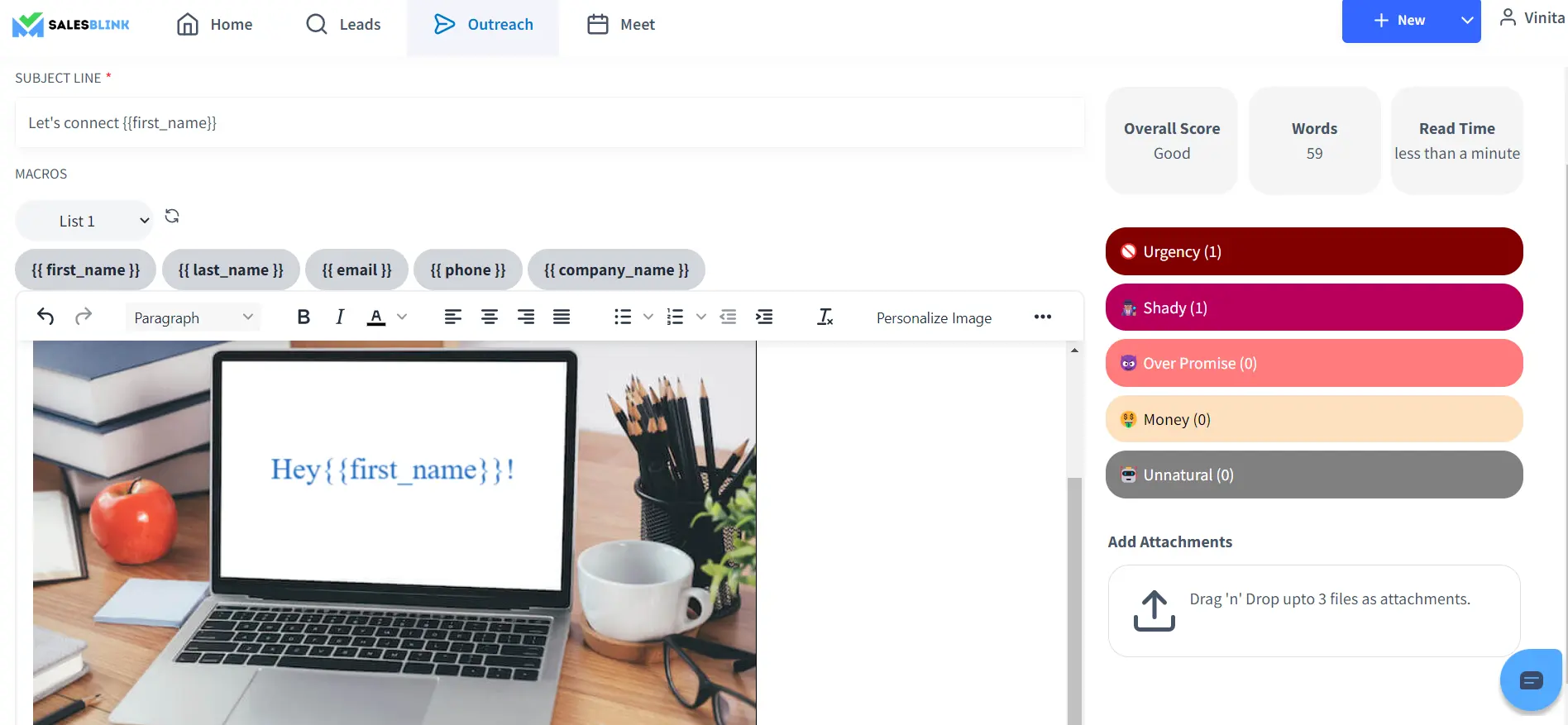
8. Address the pain points of prospects
Your email will get a reply only when you try to address the prospect’s pain points. When you provide a solution to their problem or tips to help overcome objections, the prospect will show interest in you. Therefore, you have to carefully study the prospect’s issue and how your product or service can help them out.
9. Provide something of value
Trust building is essential if you are reaching out to a prospect. You can do so by offering a valuable resource to them. People will trust you when you offer them something while expecting nothing in return. According to psychology, the prospect will have the inclination to repay your favor. So, if you provide something of value, the prospect is likely to reciprocate by giving you something in return. It may be a purchase or a referral, and you know that both can be useful for you.
10. Try to give proof for the claims you make
You have to prove what you claim in your cold outreach email. Simply giving promises won’t do. You have to show them that you have helped others get the desired results. Prospects in general, look for the names of the companies you have helped so far along with the statistics. It is a must for you to present proof if you want to look credible to the prospect.
11. Align your CTA and offer/lead magnet right
You would often offer a lead magnet to a prospect or a free trial. You have to ensure that it has to match the CTA (call to action) when you make an offer.
If you are offering an ebook, you can say something like, “Are you interested? Reply to this email, and I will send the ebook to you.” If you are giving free tickets for an event, you can put it this way – “Do you want to attend? Reply with a ‘Yes’, and I will send the ticket to you”.
12. Perform A/B test
Not sure about what will resonate well with the target audience? You always have the option to split test or A/B test your email. Create two email versions and perform the test to find out which one fares better.
13. Add an email signature
End your email with your professional-looking email signature. Keep it as simple as you can, but add relevant details to it, such as a link to your company’s website and ways to reach out to you. It gives the prospect a chance to visit your website and find a little more about you and your company.
14. Spot the typos
Don’t just blindly hit the send button after you are done typing. You have to proofread your email so that there are no spelling mistakes. It would be a good idea to use a tool that corrects your spelling and grammar so that you can save time. By ensuring that your emails are free of typos, you are putting your best foot forward, likely to fetch you handsome rewards.
15. Focus on follow-ups
Following up after your cold email is the most important part of winning. However, not many salespeople follow up persistently. Almost 44% of reps drop out after one try, while 80% of sales deals need up to 5 follow-ups to close successfully.
You can use SalesBlink to automate your cold emails and follow ups. It will save you the time you would otherwise spend on sending emails manually.
With the sequence builder you can set the sequence and the tool with take care of the rest.
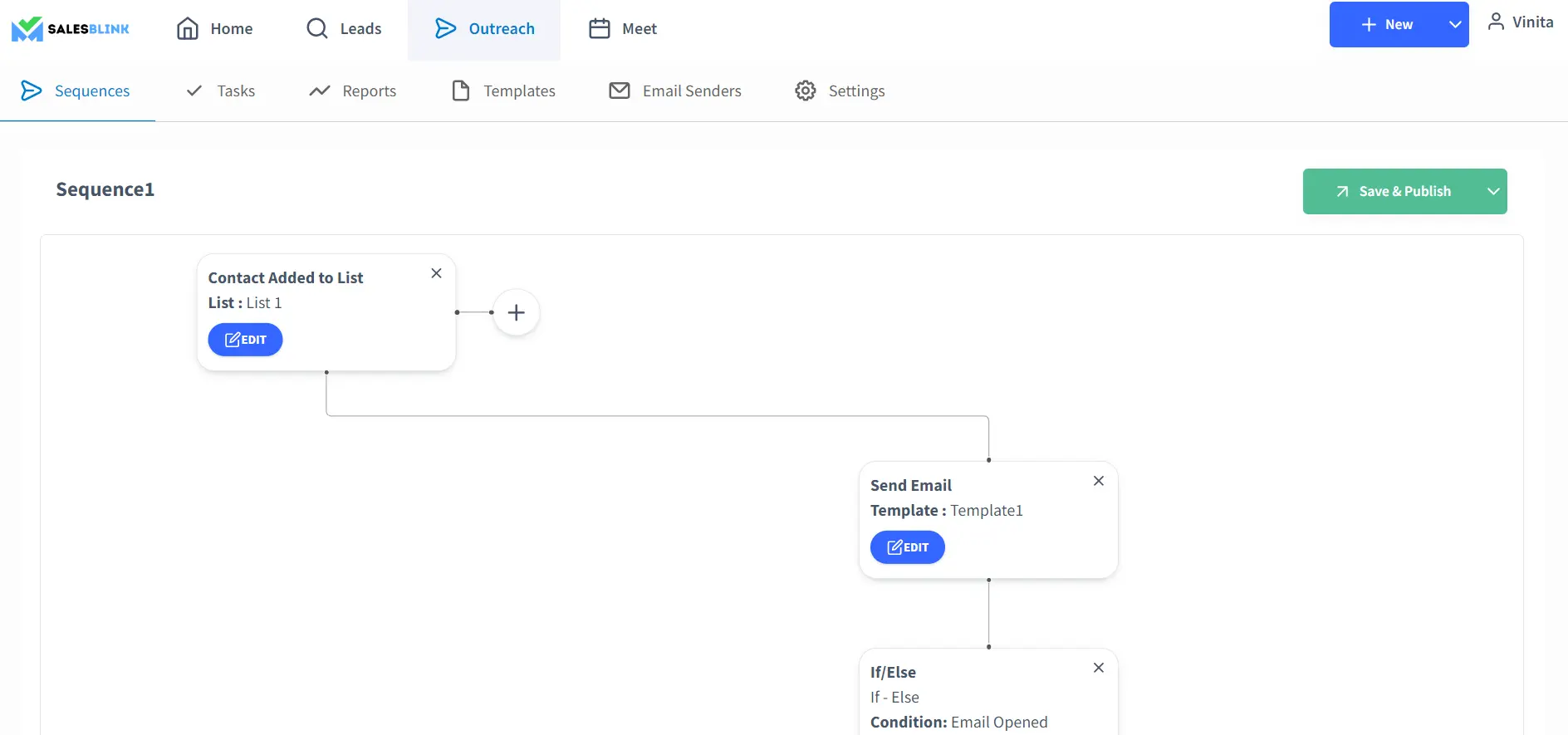
With that, we come to an end with cold email tips and best practices. Let’s move on to templates.
So, that was about what to add to your cold outreach strategy.
Cold Email Outreach Templates That Work
Apart from our cold email outreach strategy. Here are a few cold email templates that you may find helpful,
1. Giving a compliment to the prospect
Hi {{First_Name}},
I just felt like telling you that I am really impressed with your body of work at {{Company_name}}. It would be great if I could be of some help to you.
I have a lot of experience in the {{industry}}, and I blog about it regularly– here’s the link {{Blog_Link}}.
It would be amazing to connect on a quick 5-minute call about what you think about {{blog_ topic}}. Here’s the link to my calendar.
Thanks,
{{your_name}}
2. Reaching out after the visitor downloaded your ebook
Hi {{First_Name}},
I am {{your_name}} working with {{company_name}}.
It came to my notice that you downloaded our ebook from our website. I hope you have found it useful. If you have any questions, feel free to ask us.
As discussed in our ebook, we have found out that many people are facing {{pain_point}} but cannot understand that they need to find a solution for it.
We have made another ebook on the topic, and it has helped a lot of businesses achieve their goal. If you want it as well, reply to me, and I will send it to you.
Thanks,
{{your_name}}
3. Using the AIDA formula (Attention, interest, desire and action) to get a reply from the prospect
Hi {{First_Name}},
As a {{prospect’s_role}}, it can be hard to resolve {{prospect’s_problem}}.
Our solution {{name_solution}} helps reduce the burden and {{short_sales_pitch}}. Take a look at what our existing client has to say about us,
{{customer_testimonial}}
Are you interested in enjoying similar benefits? If yes, can we connect on a quick call this week? Here’s the link to my calendar.
Thanks,
{{your name}}
4. Asking a relevant question in the email
Hi {{First_Name}},
Do you want to see how you can {{product’s_benefit}}? As I know that you are occupied, I won’t take much of your time.
I am {{your_name}} with {{company’s_name}} and I have some suggestions that can help you with {{prospect_work}}
{{tip_1}}, {{tip_2}}
Probably, you may not have the time to involve yourself in this, which is why {{your_product}} can be helpful. Are you ready for a 15-minute call so that we can discuss this in detail?
Thanks,
{{your_name}}
5. Start the conversation with the help of the latest news in the industry
Hi {{First_Name}},
Congratulations on the fresh sanction of funds. Your company is already doing rounds in the {{industry}} world thanks to the amazing reviews about you on {{website_name}}.
I wanted to congratulate you and tell you that I am waiting for more good news from your end.
I am {{your_name}}, and I work with {{company’s_name}}. We {{your_solution}}. If you require any help, reply to this email.
Thanks,
{{your name}}
You can make the above templates a part of your email campaign.
Cold Call Outreach
Let’s learn about cold outreach best practices you must follow when using the phone.
What Is Cold Calling?
Cold calling refers to the task of reaching out to prospects over-call without having a prior connection with them. The receiver may not even know about the existence of the product/service or business the sales rep talks about in the call.
The popular opinion is that cold calling is dead. However, there is very little truth in it. Cold calling has evolved and is an effective outreach tactic to date.
Many feel that cold calling is against the law, but that is not true. As long as you follow the rules and regulations meant for it, you are free to make cold calls. With that cleared, we can proceed with the best practices you should follow for cold calling.
Cold Calling Best Practices
1. Learn about your prospect
If you think cold calling is about picking up the phone, dialing a random number and pitching your product, you are wrong! While the person on the other end may not know you, you need to be prepared.
Learn as much as possible about their company and its pain points. When the prospect realizes that you are already aware of the challenges they face, you are more likely to get an affirmative reply. In your call, highlight how your product or service can alleviate the prospect’s pain points. You have to be convincing enough to make an impact.
Try to find out whether the prospect is a perfect fit for your product/service or not. The most common parameters to look for in a company are its vertical, size, location, and technologies. As a potential customer, you have to look for their job title and the tools they use. This way, you would reach out only to those who fit into your buyer persona, thereby saving a considerable amount of time at both ends.
2. Offer something relevant in return
Prospects will only listen to you if you have something to offer them. That is why it is better to be ready with your resources. Ensure that it is relatable and relevant to the potential customer. You can offer ebooks, white papers or invite prospects to webinars for the time they set aside to listen to you.
3. Avoid sticking to scripts
Though a call script can guide you through the call, you need not stick to every line. Your conversations should look real and not as if you are reading out word by word. Just note down questions you want to ask the prospect, and don’t forget to keep them open-ended. Present them in a way that shows your interest in building a long-lasting relationship with the prospect.
4. Be ready to answer questions
You have to prepare yourself for the answers the potential customers will ask you. Make a list of them and be ready with the answers to look knowledgeable. When you pose as an expert in your vertical, prospects will trust you and look up to you. The chances are that they might get impressed with you and close the deal, taking you close to meeting your sales quota.
5. Minimize distractions
Before you start cold calling, you have to get rid of distractions. Try keeping devices away, have a quiet environment around you and ask your colleagues not to disturb you. Your full concentration has to be on your prospect. You can expect positive outcomes only when you give them your undivided attention. Nobody would be interested in half-hearted calls.
6. Confirm the next action before ending the call
The prospect may tell you that they are busy when you try to speak to them. However, you can always end the call by asking them the right time to reconnect or how they want to communicate with you. If your call doesn’t get an answer, note it down in your CRM and try calling later. You can always leave a voicemail and send an email to supplement it so that the potential customer knows about your intention of calling.
7. Find the best time to cold call
If you have not discovered a cold calling schedule that works the best for you, you have to buckle up soon. It is easy to find the best times to call by carefully monitoring when the prospects are more likely to answer your call and speak to you. Calling prospects at the right time will help you get better results. Lunch-time and before the end of the day are the two best times to connect. Find out which time of the day would get you in an active conversation with the prospect.
Are you wondering what you would do the rest of the day? Well, you can invest that time to plan and prepare for a call and make changes to your call script.
8. Be ready to face rejection
The prospect rejecting you upfront can be hard to accept, but you have to be prepared for it as a salesperson. While you want to hear a yes from the prospect, you have to make it a habit not to ponder too much when the prospect says no. Instead of sulking in a corner, come out in the open and note down the objections you faced so that you can work on them and get ready for future calls.
9. Learn the art of leaving voicemails
While cold calling, there are times when the prospect won’t pick the phone up, and you would have to leave a voicemail. Here too, you have to make a lasting impression. Deliver only one message in your voicemail to avoid it from getting too lengthy. Be ready with a script for your voicemail messages and make sure that they are full of energy with some urgency in them. Use the name of the potential customer, and don’t forget to mention your name on the voicemail.
10. Practice well
To improve your skills, you can practice making cold calls with your co-workers by asking them to raise the difficulty level gradually. Also, record your sales calls so that you can listen to them again and understand how well you are presenting your pitch to potential customers. You can share what you learned from your call records with the whole sales team so that you can work on it collaboratively.
11. Consider documenting the call
Once you are finished with the call, it would be a good idea to document it as soon as you can. Note the points down while you can recall the conversation to avoid missing anything. The call details can work in your favor by allowing you to start a conversation.
12. Seek the help of technology
Don’t remain stuck with dialing numbers manually. In this age of technology, you shouldn’t use conventional methods. You can use outreach automation tools to reduce the repetitive tasks involved in cold calling.
Cold Calling Script Templates
Here are a few call scripts that you can use when reaching out to prospects via phone calls,
1. Template to present your sales pitch
Hi {{prospect_name}}, this is Laura from SalesBlink. I am reaching out to SMBs in our industry to help them alleviate {{pain_point}}
Our tool, {{tool_name}} helps {{sales_pitch}}
Would you be interested in it?
2. Template to get the gatekeeper’s help
Hi, this is Gregory. Would you please help me? Are you the person who picks up the calls? It would be great if I know your name before asking for help.
(wait for the reply)
(Repeat the name of the gatekeeper with a thank you)
I want to speak to {{prospect’s_name}} who is incharge of {{department_name}}. Can you guide me?
3. Template to ask about the email you sent
Hi {{prospect’s_name}}, this is Jonathan from SalesBlink. I had emailed you last week. Did you read it by any chance?
(answer based on what the prospect says)
I sent you an email as I came to know that you are handling {{department}} at {{prospect’s _company}}, am I right?
4. Template to follow up after a voicemail
Hi {{prospect_name}}, I left a voicemail 5 days back about {{purpose}}. Hope you got a chance to hear it.
To remind you, our solution {{value_proposition}}. I would be delighted to demonstrate how we can {{benefit}}.
Can we get on a call to discuss {{solution_name}} in detail?
5. Template asking for referrals
Hi {{prospect_name}},
This is Ted from SalesBlink. I came to know that you are a fan of our blog, and I wondered if I could get a favor from you.
Are you in touch with anyone else in {{industry_name}} who would benefit by using our solution? We would offer extra features to your friend and give you an additional discount on your monthly subscription plan for every friend you refer. Do you know anyone?
Let us now move to LinkedIn outreach.
LinkedIn Outreach
Heard of social selling? It is a good change from the routine cold emailing and cold calling as it can be quite effective. You can connect with the prospect on a one-on-one basis which is better than the conventional channels.
LinkedIn is a widely-used networking platform by professionals, and you can connect to people easily through it. There is instant messaging as well, and you can find out when prospects are online to carry out conversations in real-time.
What Is LinkedIn Outreach, And Why Do You Need It?
LinkedIn outreach refers to sending connection requests to individuals who fit your ideal customer profile. Once they get connected, you can use Inmails to communicate with them.
LinkedIn is the best platform for generating leads, and it becomes powerful when you combine it with other channels of outreach. Usually, it is good to start with LinkedIn outreach and then move ahead with emails and calls. Offering a variety to potential customers can help them engage with you better.
Reaching out to prospects on LinkedIn is quite similar to email outreach compared to other social media platforms. Therefore, for LinkedIn outreach, you are free to use your email outreach tactics.
Tips For Writing The Perfect LinkedIn Cold Outreach Message
Here are a few best practices for effective LinkedIn outreach,
1. Focus on quality over quantity
It is better to send well-crafted messages to prospects instead of concentrating on the volume of the messages. You must craft relevant and personalized messages to ensure a reasonably good response rate. Simply blasting out message after message without focussing on the quality won’t benefit you in any way.
2. Avoid selling immediately
You have to build a relationship with the potential customer and not jump into selling your product or service straight away. If you choose to sell right at the beginning, there are high chances of getting pushed to the corner. Don’t send spam-like messages, and try to offer value to the prospect if you seek their attention.
3. Look for common ground
The biggest plus point of LinkedIn outreach is that you can find a lot of information related to the prospect’s job title, educational background, work history and much more. Before you connect with a prospect, it is better to learn a little about them and find out what you share in common with them.
If you happen to belong to the same town or are from the same college as the prospect, you have a great conversation starter in hand. Use it in the first message to the prospect to make it look personalized and targeted. Learning about the prospect from their LinkedIn profile and tailoring your message according to that will make the prospect happy. They would appreciate the efforts you put in to learn about them and are likely to pay attention to you.
4. Pep up your profile
Before reaching out to people on Linkedin, you have to work on your profile and make it attractive. Your bio should explain how your services will be helpful to a potential client. Show them how your offering can help them in achieving their goal. Keep the words as simple as you can to convey your message without any friction. Add a professional photo, interact with groups and publish original yet relevant content to showcase your knowledge of topics in your industry.
5. Use a mutual connection
If there is a person to vouch for you, it becomes easier to connect to someone you don’t know. Having a friend or a coworker in common can be a huge plus. You can simply mention the mutual connection in your message to the lead. Here’s an example,
Hi <first name>, I learned that both of us are connected to <mutual connection’s name>, so I thought of connecting with you too. We met at an event and became friends. Can I know how you know <mutual connection’s name>?
6. Keep it compact
Instead of comparing LinkedIn messages to emails, compare them to instant messages. Unlike emails, you don’t have to send paragraphs. Short and to-the-point sentences would do, but at the same time, you have to keep the warmth intact. Mention how you landed on their profile, highlight common ground or what about them you find interesting.
7. Keep the conversation going
Make sure that your message gives the prospect a reason to reply so that the conversation doesn’t come to a halt. By choosing to end your message with a question, you make that possible. It can be a question about their job role, experience, body of work, etc. You can even ask for their opinion on a topic and increase the chances of getting a reply.
8. Emphasize value from the prospect’s view
Prospects are flooded with sales emails, and if you want to make an impact, you have to stand out. One thing you can do is ask yourself, what makes your offer better than the hundreds of others? If you choose to emphasize the value of your product or service from the prospect’s point of view. Try to make the prospect know how they can benefit and how your solution can alleviate their pain points.
9. Be persistent with follow-ups
It would be a must to follow up with your potential customers as you can’t hit the bull’s eye with just one message. Also, it is highly unlikely that you reach out to just one person at a time which is why you should try to invest in a sales outreach automation tool. It would assist you by keeping track of the people you have to follow up with, thereby saving a considerable amount of time.
LinkedIn Templates To Get More Responses
1. Here’s a template to make a connection request
Hi {{prospect’s_name}}, I saw that you liked the blog post about {{topic}} on {{website_name}}.
Thought of reaching out to you as I believe we have common interests. Why don’t we connect {{Your_name}}
2. Here’s a template that uses a mutual connection
3. Here’s a template to reach out to a prospect in the same group on LinkedIn
Hi {{prospect’s_name}}, I chanced upon your profile on {{name_group}}.
I thought it would be good to connect with you as I am searching for people with a similar vision. You seem to have a lot of experience in {{industry_name}}, and it would be great to discuss the latest developments. Are you interested in getting connected? {{your_name}}
4. Here’s a template to follow up
5. Here’s a template to offer a free trial after the prospect connects
Start With Cold Outreach & Get Booked!
As you have seen, sending cold emails, making cold calls and connecting with prospects on LinkedIn is an important part of cold outreach. A good mix of multiple channels can help you achieve better results over a short period. It will even help you find out which channel is most preferred by prospects so that you can shift to it. Follow the best practices for cold email outreach mentioned in this post for each outreach channel to get the desired outcome.
You can thank us later!
FAQs
Cold outreach refers to reaching out to prospects who don’t know about your business or the product/service you are offering. It is a cost-efficient and effective way of getting people to know about your offering.
Cold email outreach refers to sending emails to individuals with no existing relationship with you and your business. So, the recipients don’t even anticipate getting an email from you as they don’t know you.
LinkedIn outreach refers to sending connection requests to individuals who fit your ideal customer profile. Once they get connected, you can use linkedin Inmails to communicate with them.
